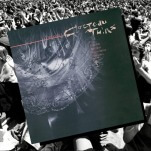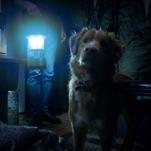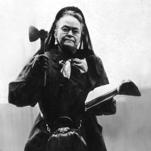Star Trek: Picard EP Akiva Goldsman Explains the Season Finale’s Biggest Twists
He also reveals that Riker and Troi weren't originally a part of the writers' plans for the season.
Photos Courtesy of CBS All Access
![]()
[Editor’s Note: The following contains spoilers for the Season 1 finale of Star Trek: Picard, “Et in Arcadia Ego, Part 2.”]
Veteran writer, director, and producer Akiva Goldsman, when asked by Paste about how Star Trek fits into his life, had a very honest answer: “Star Trek is way too much of my life, but I like it like that. I have a unique relationship with Star Trek, in that the 14 year old boy in me is delighted at the opportunity to get to go to Star Trek to work. So any free moment I have, I can spend with Star Trek.”
Thus, Goldsman doesn’t just serve as an executive producer on Star Trek: Picard, but directed the final two episodes of Season 1, and has story credits on both. This meant he was more than capable of answering our nerdiest questions about the season’s conclusion, which featured a colony of synthetic beings fighting for their right to exist, and potentially calling in a terrifying threat from another realm.
Below, Goldsman digs into the biggest twists of the finale, including why Picard had to die—at least briefly, before becoming a synthetic recreation of himself, ready to take on a new adventure in the already-greenlit Season 2. Goldsman also reveals why the writers didn’t originally plan to include Riker and Troi, and why Stewart was a very (sorry) engaging person to work with in the writers’ room.
This interview has been condensed and edited for clarity.
Paste: So, how do you feel like audiences have been reacting to the season?
Akiva Goldsman: I try not to over-engage in audience reaction. The world is so loud now—the vigor with which people like and dislike or admire or admonish is so intense. So I probably will not really deeply engage audience reaction until Episode 10 has aired.
It was very interesting—at the beginning, I could hear over the transom [people saying] “Oh, it’s so dark, it’s so dark.” But if you reviewed the first act of any movie you’ve ever liked, it would feel really dark, because all redemption stories require something to cure.
Paste: It’s interesting that you call it a redemption story, because that’s something I hadn’t ever thought about while watching.
Goldsman: Well, we really wanted to sequel-ize the Picard character of Next Gen, right? We didn’t want to make more Next Gen. We loved Next Gen but that climb was done, so we needed all those things that drive a character forward, right—loss, guilt, wounds in your ego. And Nemesis looms large, right. So there we have this unresolved death, we have this moment of sacrifice that’s created a tremendous amount of emotion in Picard. So we wanted to explore what would that have done to him, how would that have moved him forward? Who would he have become after that?
And we extrapolated then to this Picard who has [withdrawn]. He doesn’t get to finish being Picard. And so, for us, this was the way that you could sequel-ize, the story by letting him revisit the character he was and then step into a character he could become. That’s any redemption story.
Typically, those stories end with self-sacrifice, which is what we did here, we just cheated it. I say cheated—I mean, we knew we had to kill him. And of course, we couldn’t kill him.
Paste: So, you knew you had to kill Picard, but you also knew he couldn’t stay dead. What went into conceiving that?
Goldsman: You know, the next chapter in the great book of Star Trek is empathy, always, right? I think when Star Trek is working, and you’re arguing about whether the enemy is black or white on the right or left side of his face)—that’s how Star Trek begins, which is always about how do you see the person across from you? Do you see them as the same or different? Do you see the other meaning alienation? Or can it mean cherishing difference and connection?
So this season, obviously, it was synths. Does inorganic life have the same rights to exist as biological? That was the “other” of this year. So what better test for our ability to be empathetic, what better way to put our money where our mouths are, than to say that now Picard’s synthetic? Do you feel differently about him?
Paste: Going back to Picard dying—in directing those scenes, how do you make sure that it still has that emotional weight, knowing that he’s coming back?
Goldsman: Well, I think that is the magic trick of actors, right? Because it is actually no different than staring at a green screen and pretending you’re flying through transwarp. It’s a commitment to the imagination. And in a strange way, arguably, it’s easier because we have all actually lost someone. Anyone who hasn’t is extraordinarily lucky in this life, right? We’ve all lost someone we love. And so, as actors, they have this ability to reach to that personal [tragedy] and communicate it. Meanwhile, none of us have actually been through transwarp. So they’re just making that shit up.
Paste: To another point, this season brought in both a lot of new characters and returning faces. When you guys were in the writers room, what was key to kind of finding that balance of new and old?
Goldsman: It’s a fair question that we gave a tremendous amount of thought to. This is a Star Trek show made by Star Trek fans. We have this tremendous love for the canvas. We just love it. But the show has to be good for us, and it has to be good for somebody who’s never seen [Trek], who didn’t care about it, who just wanted a good story, who wasn’t a canon aficionado.
As such, what we said is what is the most specific and most effective way to tell a story? Not how can we smuggle in something that is a wink and a nod to just us, right? If we were going to pull in something from Star Trek history, it has to be the very best possible way to tell the story. It couldn’t just be low hanging fruit.
So we did not design the season to have Troi and Riker in it. I mean, Jonathan [Frakes] was with us from the beginning—he’s a director on the show and he’s a super fun, collaborative part of the Star Trek team, but we weren’t thinking of Riker.
Then we got to this place where Picard had to find somebody that he could trust above all people. We thought well, this Captain in this story, he obviously has served with people and he must have had a first officer and a best friend. And then you’re like, “Oh, fuck, it’s Riker.” And it’s the greatest thing that ever happened. What you’re experiencing hopefully is that it really did come out of story. There was no way just to throw Riker in — he had to have a story that fit into this story, a history that made sense. And as such, hopefully it feels organic. I mean, to me that episode, “Nepenthe,” is my very favorite. You know, I just couldn’t be happier being back with those guys.

Paste: Meanwhile, I feel like this is something that comes up every time Brent Spiner plays a different version of Data, which is is you know whether Lore was ever part of the conversations had in the writers room when it came to this season.
Goldsman: I mean, Lore was a part of the conversation only insofar as we discussed the structure of the Soong dynasty—Data’s creator and his “family.” Right. So we would talk about the Soongs, we would talk about Lore, but not as an antagonist. We never thought “let’s put Lore in it.” Not for more than a second.
Paste: The reason I asked is because kind of notoriously Star Trek: Nemesis never brought up Lore, even though there was a clear reason to do so.
Goldsman: We weren’t feeling a pressing need to discuss Lore, although obviously we were deeply in consideration of those things that might have been more articulated when it came to the events of Star Trek” Nemesis—most pointedly, obviously, Data’s death. Obviously, a lot of this season is generated by the opportunity to revisit that.
Paste: Another very nerdy question: When Data and Picard are speaking inside the construct, and the door opens for Picard to essentially come back to life, it whisks open with the same sound effects heard when doors would open on the Enterprise-D. Was that a deliberate choice?
Goldsman: Yeah, you know, obviously this is not the Nexus, right? But a large part of the construct is in large part based on the neural patterns that are both in, you know, that are extrapolated from Data and now Picard, so, it’s a little bit the creation of a world that is familiar to them, as if there’s some heuristic algorithm in there that sort of making the world comfortable for them. It’s not all ones and zeros. That wasn’t scripted; it was a mix choice.
Paste: Another big moment that felt like a reference was when the other synthetic beings begin to invade from the other realm—in my notes, I wrote down “techno-Cthulhu.” What was the thought process behind developing that design?
Goldsman: I think that there is always some version of the lurking hulking thing which lives behind the walls of the world, and I think that it’s hard not to go to Cthulhu. I would not have minded seeing the body, but ultimately, we just couldn’t wait to get it. We actually could neither conceptualize it in time nor probably ultimately executed it in time. So we went with the teaser, the tip of the thing.
Paste: And it’s effective.
Goldsman: Thank you. I’m so glad to hear that. What happens ultimately, when you make a thing at a sprint, which these things almost inevitably are, you can’t really tell anymore, especially when it comes to visual effects.
Paste: What worked about it for me personally, it was just the fact that it was very clearly artificial.
Goldsman: It’s funny because the shapes [of the tentacles] are so organic, so we had to keep driving many iterations, because we saw it was still feeling a little too bio-slimy. So we kept pushing it, until we finally got the fact it was clearly constructed.
Paste: To wrap things up: Patrick Stewart was in the writers’ room for at least a period of time. What it’s like, trying to write a character with the actor in the room?
Goldsman: The dirty little secret here is that most of us end up writing characters with the actor in the room. Even if they’re not literally in the room, if you are lucky enough to still be typing when they’re making this thing, then you’re collaborating—even if not practically, then imaginatively, with that voice.
[Stewart] knows Jean-Luc Picard better than any of us for so, and he’s smart, and he’s kind and he’s collaborative, and what you need in a writers room is smart, kind and collaborative. Those are the keys to making it work — and then [you get] that expertise simultaneously. It’s just a win And then also you’re sitting there, going, “holy shit, it’s Jean-Luc Picard.”
Paste: Did he ever end up using the line, “you know, Jean-Luc Picard wouldn’t say that”?
Goldsman: He didn’t, but you could feel it. The great thing about Patrick is, he’s been acting for longer than at least some of the writers have been alive. And so he knows how to work with writers. But yes, now and then he would go “no, no, no,” and on the third “no,” you say “Okay, what I meant was…” You change it, because that was what the “no” that had built into it — “yeah, Captain Picard wouldn’t say that.” But he never actually had to say those words.
Liz Shannon Miller is a Los Angeles-based writer and editor, and has been talking about television on the Internet since the very beginnings of the Internet. She recently spent five years as TV Editor at Indiewire, and her work has also been published by The New York Times, Vulture, Variety, the AV Club, the Hollywood Reporter, IGN, The Verge, and Thought Catalog. She is also a produced playwright, a host of podcasts, and a repository of “X-Files” trivia. Follow her on Twitter at @lizlet.
For all the latest TV news, reviews, lists and features, follow @Paste_TV.







































